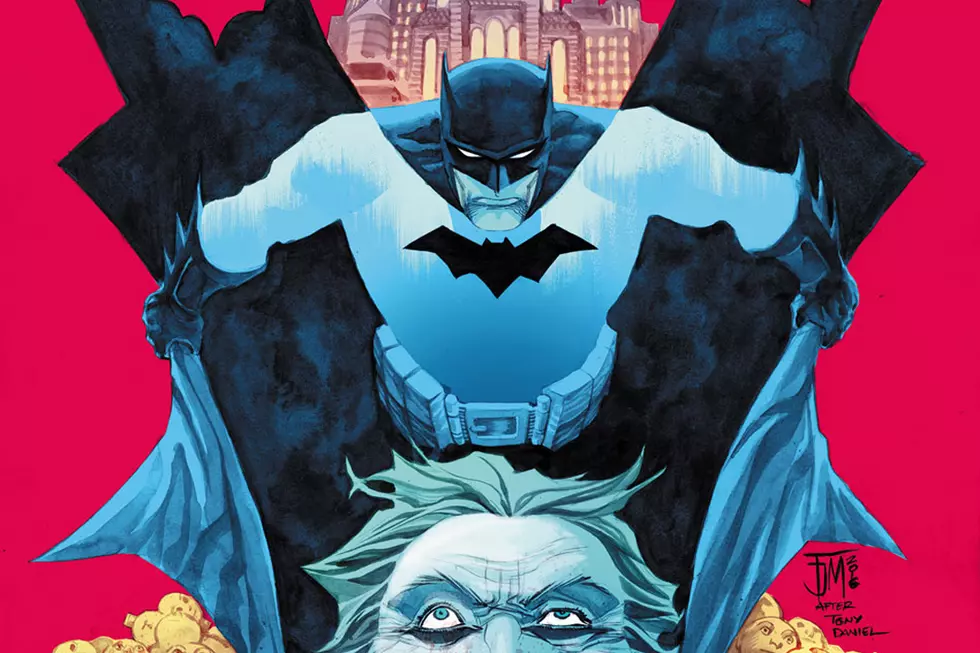
The Continuity of the New 52 DC Comics: What Changed in Week 1

Last week we took a look at Flashpoint #5 and Justice League #1 regarding the changes they'd made to DC continuity, but this week we've got a lot more to discuss. While some of the titles have minimal changes or are complete reboots, more than a few are tweaks on the old DC continuity. So while these books are ostensibly without history for new readers, if you're a DC Comics continuity nerdlinger like me, you're probably wondering what changed in the continuity of DC's New 52. Here's your guide, and watch out for spoilers!
 Action Comics #1 (Grant Morrison & Rags Morales)
Action Comics #1 (Grant Morrison & Rags Morales)
This one's an almost total reboot, but in classic Morrison style, it contains more than enough clues and nods to past and future continuity that, well, I'm just gonna do some mini-annotations here. With so little to go on, full-on page-by-page Batman-style annotations probably won't be necessary for a few issues, but there's still more than enough worth commenting on.
First off, this shows a little-written-about period in Superman's history five and a half years before the "present day" in a completely new light. While set early in Superman's career, it's not an origin story; Ma and Pa Kent don't even appear in the issue, and Clark's already decided to be Superman long before it begins. He's wearing jeans and a T-shirt and thinking before he leaps -- and leaping is what he does, since he hasn't been exposed to the sun long enough to start flying yet. His powers are still increasing, as Lex Luthor -- here, a consultant to the U.S. Army hired to take down Superman -- comments.
Jimmy Olsen is no longer Superman's best pal, but Clark Kent's. He and Lois work at the Daily Planet while Clark Kent works at the Daily Star, its competitor. His relationship with Lois is almost nonexistent, other than as his best friend's coworker.
That said, there are more than enough hints to the future, such as Clark's neighbor Mrs. Nyxly (whose similiarity, visually and in name, to Mr. Mxyzptlk can't be denied -- as well as '70s villain Ferlin Nyxly, thanks Mark Waid) as well as his "friends," two men and a blonde woman, who are likely Lightning Lad, Cosmic Boy and Saturn Girl of the Legion of Super-Heroes. Jimmy Olsen jokes about his cellphone being his "own personal stalker" as it makes a ZEE ZEE ZEE sound, a clear nod towards his signal watch that summoned Superman in old continuity.
 Animal Man #1 (Jeff Lemire & Travel Foreman)
Animal Man #1 (Jeff Lemire & Travel Foreman)
This book doesn't at all deviate from previous continuity; as a matter of fact, this issue could easily have been printed without the New 52 reboot. It follows completely from Grant Morrison, Peter Milligan, Rick Veitch and Jamie Delano's runs on the character.
Batgirl #1 (Gail Simone & Ardian Syaf)
This one has the most modifications. While Barbara's paralyzation in Alan Moore and Brian Bolland's seminal The Killing Joke remains in continuity, it's only been three years since then, and Barbara's since regained the ability to walk due to an unspecified "miracle." Whether her years as Oracle occurred is unclear; she certainly spent time in a wheelchair, and she's still a computer genius, but she's far younger than she was portrayed then and she's poor enough to need to move into a cheap apartment with a roommate, implying she doesn't have the panoply of resources, both monetary and technological, that she had as Oracle.
Batwing #1 (Judd Winick & Ben Oliver)
Almost no deviations. Batman's in his New 52 costume, but otherwise, this could have easily come out pre-reboot.
 Detective Comics #1 (Tony Salvador Daniel)
Detective Comics #1 (Tony Salvador Daniel)
Like Action Comics, this occurs seemingly five and a half years ago, yet six years into Batman's career. (UPDATE: Apparently it takes place in the present day, according to Tony Daniel, and the USA Today article I was reading is wrong.) He's apparently older than the other members of the Justice League, or has at least been operating for a bit longer (six years as opposed to Superman's five and a half). While he has a working relationship with Commissioner Gordon, there's pressure from Mayor Hady (who was also mayor of Gotham pre-New 52) to take down Batman, so he's at odds with his own cops. Alfred seems to be communicating to Bruce via hologram, implying he's either at another location or some sort of artificial intelligence. While the end of the comic has the Joker have his own face cut off for some nefarious purpose, he was wearing it during the Killing Joke flashback in Batgirl which takes place two years later, so we know that can't stick around for long.
Green Arrow #1 (J.T. Krul & Dan Jurgens)
This is an almost complete reboot of the character, inspired by his Smallville incarnation. Rather than a corporate-fatcat-who-lost-his-money-and-became-a-Liberal-crusader, he's Steve Jobs as superhero, using his Q-phones and Q-pads to track villains, armed with a new armory of trick arrows that allow his associates to hack into computers and stuff like that. He's far younger, and while former sidekick Roy Harper will be appearing in Red Hood and the Outlaws, seems to have no current sidekick and certainly no known children. His parents are still dead, and he mentions standing by while he could have saved some people being the impetus for his adopting a superheroic identity.
Hawk & Dove #1 (Sterling Gates & Rob Liefeld)
While the characters are far younger and they're switching up current Dove Dawn Granger's origin to involve a relationship with former Dove Don Hall that she's keeping secret from Hank Hall, the Hawk, as well as restoring both characters to youth and having them attend Georgetown University as in the Barbara Kesel/Rob Liefeld miniseries from 1988, events of Brightest Day have still clearly occurred, since Dawn remains in a relationship with the spectral Deadman.
 Justice League International #1 (Dan Jurgens & Aaron Lopresti)
Justice League International #1 (Dan Jurgens & Aaron Lopresti)
Also a complete reboot. The original Justice League International was the "main" Justice League team after the 1986 crossover Legends, formed by Max Lord, this new team is created by the United Nations in response to the standard Justice League, who have no governmental oversight. While many of the characters are the same -- Booster Gold, Fire and Ice, Batman, Rocket Red -- it doesn't build off of last year's Justice League: Generation Lost or the previous runs of the series, instead having this be the first meeting of the team. So while some of the characters, and much of the interaction, is the same, the team's raison d'etre and origin have completely changed.
Men of War #1 (Ivan Brandon & Tom Derenick) (Jonathan Vankin & Phil Winslade)
This is a completely new character in the DC Universe, and much like Animal Man and Swamp Thing, could easily have been published in the pre-New 52 climate. Joseph Rock is the grandson of the original Sergeant Frank Rock, and he's a soldier in a world with superheroes. That pretty much covers it. The backup is a standard war story with no reference to the DC Universe, or superheroes, as a whole.
O.M.A.C. #1 (Keith Giffen w/Dan DiDio)
This is a complete reimagination of the O.M.A.C. concept, borrowing some of the aesthetics from the 2005 Infinite Crisis version and combining them with the basic concept of Jack Kirby's original series. Brother Eye is a satellite computer who takes control of Cadmus employee Kevin Kho to transform him into O.M.A.C. and fight the genetic denizens of Cadmus. There's an above-ground Cadmus known to the public, as well as the more Kirbyesque one below, featuring Cadmus standard Dubbilex as well as Mokkari, previously of the Evil Factory and a servant of Darkseid, now reimagined as another Cadmus experiment who's taken control of the facility.
Static Shock #1 (Scott McDaniel w/John Rozum)
While Static's experiences in the pre-New 52 DC Universe -- especially his appearances in Terror Titans and Teen Titans -- seem to be erased, his history from his original Milestone series appears to be intact, with Virgil Hawkins having left Dakota City to go to New York and intern for Hardware.
 Stormwatch #1 (Paul Cornell & Miguel Sepulveda)
Stormwatch #1 (Paul Cornell & Miguel Sepulveda)
Much like Justice League International, while many of the characters (Apollo, Midnighter, Jack Hawksmoor, the Engineer) are the same, the team's origin and reason for being have completely changed. The old Stormwatch was the main public-facing superhero team of the Wildstorm Universe, led by Weatherman Henry Bendix, who doesn't appear in this issue at all. Instead, Stormwatch was seemingly founded in the middle ages by the Demon and his allies of next week's Demon Knights, and, much like Jonathan Hickman's S.H.I.E.L.D. for Marvel, worked behind the scenes to protect the Earth from otherworldly threats prior to the arrival of the superheroic age.
Additionally, out of all of the New 52 books so far, this one seems to be the most tied-in to whatever the overarching metaplot teased at the end of Flashpoint #5 is, tying in to the events of Superman #1 (out in three weeks) with a giant horn appearing on Earth and summoning the "Scourge of Worlds" in the moon, who's preparing the Earth for an otherworldly infestation, likely whatever threat the Mysterious Hooded Lady was referring to at the end of Flashpoint.
Swamp Thing #1 (Scott Snyder & Yanick Paquette)
Much like Animal Man, this title picks up completely from the end of Brightest Day, and could have been published in the old DC Universe if not for Superman, Batman and Aquaman having their New 52 costumes. (Indeed, Paquette actually had to redraw those characters when the New 52 initiative was introduced.)
More From ComicsAlliance





![DC Comics’ New 52 Edges Towards Landmark 52nd Cancellation [Analysis]](http://townsquare.media/site/622/files/2014/05/Untitled-29.jpg?w=980&q=75)

![Batman Meets Green Lantern In New ‘Justice League: War’ Clip [Video]](http://townsquare.media/site/622/files/2014/01/Justice-League-War-Clip-1.png?w=980&q=75)

